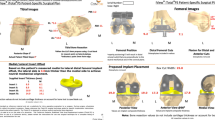Abstract
Total Knee Arthroplasty (TKA) is a highly successful surgical procedure with more than 600,000 TKA’s performed annually in the US. Interest in improving surgical outcomes has led to improvements in surgical technique, instrumentation, and implant design. Computer navigation and robotic systems were introduced to further refine the mechanical alignment of joint replacement procedures. The cost to implement some of these technologies and the additional time required in the operating room to utilize these developments has limited the acceptance of them broadly. The introduction of custom instrumentation and cutting blocks based on computed tomography (CT) or magnetic resonance imaging (MRI) has allowed for better restoration of mechanical alignment. Unfortunately, little has changed in patient satisfaction in the past ten years. The recent introduction of patient specific instrumentation and patient specific implants is another step forward to restore the pre-deformity anatomy and joint geometry. This new technology can benefit the hospital by improving operating room time efficiencies through having shorter set-up times, and the elimination of cleaning, sterilization and inventory costs. The patient can potentially benefit by a shorter operative time, improved postoperative alignment and better fitting implants.
Similar content being viewed by others
References
Papers of particular interest, published recently, have been highlighted as: • Of importance
Mahoney MM, Kinsey T. Overhang of the femoral component in total knee arthroplasty: risk factors and clinical consequences. J Bone Joint Surg Am. 2010;92:1115–21.
Wasielewski RC, Galante JO, Leighty R, et al. Wear patterns on retrieved polyethylene inserts and their relationship to technical considerations during total knee arthroplasty. Clin Orthop Relat Res. 1994;299:31.
Ritter MA, Faris PM, Keating EM, et al. Postoperative alignment of total knee replacement. Its effect on survival. Clin Orthop Relat Res. 1994;299:153.
Mason JB, Fehring TK, Estok R, et al. Meta-analysis of alignment outcomes in computer-assisted total knee arthroplasty surgery. J Arthroplasty. 2007;22:1097–106.
• Bourne RB, Chesworth BM, Davis AM, et al. Patient satisfaction after total knee arthroplasty: who is satisfied and who is not? Clin Orthop Relat Res. 2010;468:57–63. This study demonstrates that despite all of the technological advances made in total knee replacement surgery in recent years that patient satisfaction for total knee patients is far below what total hip replacement surgery delivers.
Noble PC, Conditt MA, Cook KF, Mathis KB. The John Insall Award: patient expectations affect satisfaction with total knee arthroplasty. Clin Orthop Relat Res. 2006;452:35–43.
Laurencin CT, Zelicoff SB, Scott RD, Ewald FC. Unicompartmental versus total knee arthroplasty in the same patient. Clin Orthop. 1990;260:135.
Dennis DA, Komistek RD, Hoff WA, Gabriel SM. In vivo knee kinematics derived using an inverse perspective technique. Clin Orthop Relat Res. 1996;331:107–17.
Dennis DA, Komistek RD, Colwell CW, et al. In vivo anteroposterior femorotibial translation: a multi-center analysis. Clin Orthop. 1998;356:47–57.
Dennis DA, Komistek RD, Mahfouz MR, et al. Multi-center determination of in vivo kinematics after total knee arthroplasty. Clin Orthop. 2003;416:37–57.
Radermacher K, Portheine F, Anton M, et al. Computer assisted orthopedic surgery with image based individual templates. Clin Orthop Relat Res. 1998;354:28–38.
Howell SM, Kuznik K, Hull ML, Siston RA. Results of an initial experience with custom-fit positioning total knee arthroplasty in a series of 48 patients. Orthopedics. 2008;31:857–63.
Hafez MA, Chelule KL, Seedhom BB, Sherman KP. Computer-assisted total knee arthroplasty using patient-specific templating. Clin Orthop Relat Res. 2006;444:184–92.
Sisto DJ, Sarin VK. Custon patellofemoral arthroplasty of the knee. JBJS. 2006;88:1475–80.
Lombardi AV. Patient specific knee design: an evolution of computer navigation; current concepts in joint replacement, published abstract, Winter 2007 meeting.
Lombardi AV, Berend KR, Adams JB. Patient-specific approach in total knee arthroplasty; Orthopedics 2008;31:927–30.
Klatt BA, Goyal N, Austin MA, Hozack WJ. Custom-fit total knee arthroplasty (OtisKnee) results in malalignment. J Arthroplasty. 2008;23:26–9.
Noble JW, Moore CA, Lui N. The value of patient-matched instrumentation in total knee arthroplasty. J Arthroplasty. 2012;27:153–5.
Fitz W. Unicompartmental knee arthroplasty with use of novel patient-specific resurfacing implants and personalized jigs. J Bone Joint Surg Am. 2009;91:69–76.
Disclosure
J Slamin: employed and has patents and stock options with ConforMIS, Inc.; BS Parsley: consultant to Nimbic, Inc., receives royalties and travel expenses from ConforMIS, Inc., has stock/stock options with Nimbic and ConforMIS, Inc.
Author information
Authors and Affiliations
Corresponding author
Rights and permissions
About this article
Cite this article
Slamin, J., Parsley, B. Evolution of customization design for total knee arthroplasty. Curr Rev Musculoskelet Med 5, 290–295 (2012). https://doi.org/10.1007/s12178-012-9141-z
Published:
Issue Date:
DOI: https://doi.org/10.1007/s12178-012-9141-z




